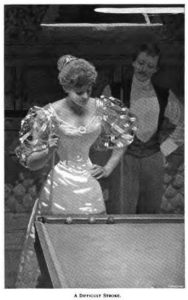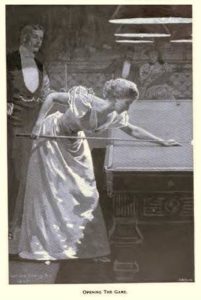In 1883, the then owner of Grim’s Dyke, banker Robert Heriot hired designer Arthur Cawston to add a billiard room to the existing property at Grim’s Dyke. The room was adjacent to what was formerly Goodall’s studio and was designed in a coarse Gothic style.
Sir William Gilbert wasn’t keen on this style of architecture. He had this room overhauled in 1890, adding a new suite of bedrooms over the billiards room and changing the exterior, to match the main structure of the building.
The game of billiards
Played by kings and commoners, males and females alike, billiards was originally an outdoor game, enjoyed immensely by the Victorians. It was played on the lawn and using maces and three wooden balls – two white, one red. Like croquet, it used hoops and pegs (or ‘kings’) and was played within the confines of a fenced area. Originally called the ‘winning and losing carambola game’, an amalgamation of three popular games it was based on.
 Billiards was a 12-point contest game, played by either two teams or two individual players. Points were scored by pocketing your opponent’s white ball or the red target ball. If, however, you pocketed your own white ball, or missed hitting your opponent’s, you lost points or forfeited them to the other team – depending on the type of move you used. It was later increased to a 16-point game and these rules stayed in force, until 1983.
Billiards was a 12-point contest game, played by either two teams or two individual players. Points were scored by pocketing your opponent’s white ball or the red target ball. If, however, you pocketed your own white ball, or missed hitting your opponent’s, you lost points or forfeited them to the other team – depending on the type of move you used. It was later increased to a 16-point game and these rules stayed in force, until 1983.
The move from outside to indoors
During the late 17th Century, billiards was moved indoors, played onto rectangular tables. These tables were covered with a green tablecloth – to represent the grass, and a wooden rail was constructed to keep play in place. It still used two white ball and a single red target ball, however one white ball now had a black dot marked on it, to enable differentiation from the other.
The wooden balls were replaced by ivory ones in the 18th Century and, by the mid-18th Century, coloured balls were introduced. The rails around the table had padding added to them, to help with rebounds. As the other end of the mace was so often used to hit the balls, the stick itself was also redesigned and became known as a cue. In 1807 it was padded with a small piece of leather, to help control how the ball moved when struck.
How the Industrial Revolution helped the game of billiards
Billiard equipment improved rapidly during the Industrial Revolution. The leather tip was perfected in 1823 and chalk was used to increase friction. The cue changed again in 1829, when the two-piece cue was introduced. 1835 saw slate becoming the most popular choice of table material. Rubber vulcanization was discovered by Goodyear in 1839, and this bought about further billiard table changes as, in 1845 it became the standard choice for the table cushions.
By 1850 the billiard table became how we know it today – with a standard two-to-one ration of length to width.
 Tournaments and governing bodies
Tournaments and governing bodies
During the 1870’s billiards champions were decided by challenge. The first professional tournament was held in 1870 and this continued until the mid-1950’s. Challenges would be issued to the title holder and stake money was held by a third party – with the winner walking away with the prize at the end of the challenge. As with many of our modern sports though, an official association was needed – and in 1885 the English Billiards Association was finally created.
Billiards is still an incredibly popular pastime and sport, with the World Professional Billiards and Snooker Association being the main governing body.


